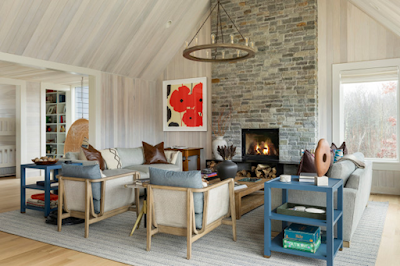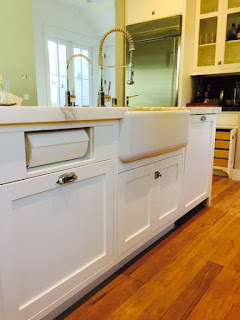7 Common Decorating Mistakes to Avoid
by Georgia Madden
Pros share solutions to design problems they often find in people’s living spaces
A beautiful color scheme and nice furniture aren’t all that
goes into an appealing living-room arrangement. There are other factors to
consider, such as balance, proportion and placement. Not sure what that means
for you and your living room? We asked three design experts to reveal the most
common styling errors that people make and how you can steer well clear of
them. Accompanying the story are images of beautifully designed living rooms
that get it right.
1. Rug That’s Too Small
“A great rug can be the making of your living room. It
grounds your furniture and, in an open-plan space, defines the living area,”
says Gabrielle Reinhardt, interior designer at Berkeley Interiors.
“The most common mistake people make when purchasing a rug is choosing one
that’s too small for both the room and the furniture in it,” Reinhardt says. “A
too-small rug sits separately from the furniture in the room, making the space
look disjointed and feel uninviting.”
2. Television Is the Focus of the Room
“The television is the ruin of most living rooms,” Reinhardt says. “Many
homeowners will choose an oversize television that is too big for the room and
then center all the furniture around it, forgetting that the living room is for
entertaining and conversation too.
“I also often see living rooms with nothing in them but a television and a
modular sofa or a sofa and a chaise,” she says. “A bare set-up such as this
makes the room feel cold and unwelcoming, and suggests that the living room has
no purpose beyond watching television — which can be an instant conversation
killer.”
Solution. “The television can be an integral part of your living room without being the focus of it. The key is to conceal it as much as possible and create a space that performs dual functions as a watching zone and relaxing/social space,” Reinhardt says.
“A built-in wall of cabinetry or a ready-made cabinet with shelves are two
smart ways to detract attention from a television or conceal it altogether. Use
the open sections of the cabinetry to house books, photos, ornaments and other
interesting things that will draw the eye from the television and add
personality to the room,” she says.
“Also consider having a smaller television in your living room and keeping the
oversize screen for a media room or spare room — if you’re lucky enough to have
one — where it can be hidden behind closed doors,” Reinhardt says.
3. Squashing All the Furniture Against the Wall
“Pushing all your living room furniture up against the walls is another common
styling mistake people make,” Reinhardt says. “I often see rooms where the sofa
is against one wall, with a pair of armchairs against another, and the coffee
table stranded in the middle of the room where nobody can reach it. The result
is a dull room that feels a little like the waiting room in a doctor’s surgery.”
Solution. “Moving the furniture deeper into the room and setting up
conversational zones will instantly make your living room feel cozier and more
welcoming,” she says.
“The arrangement that works best will depend on the shape and size of the room.
You may decide to put the sofa against a wall, with a pair of armchairs
opposite it and a coffee table in between them. Or, if your living room is
spacious, you may choose to place the furniture near the middle of the room,
with space around it to move about,” Reinhardt says.
4. Sofa That’s Too Big or Small
“Selecting a sofa that’s the wrong scale for your living room is the
biggest blunder people make,” says Lily Cumberland, interior designer at Coco
Republic. “It’s important to remember that a sofa will often appear to be quite
different in size once it’s out of the showroom and in your home.
“Color can also have an impact on how big a piece appears. A dark sofa with
a skirt that goes to the ground, for example, can look quite heavy or imposing
in a very small living room,” Cumberland says.
Solution. “Measure up your living room, the other furniture in the room,
and the sofa you have your eye on before you buy. Always start with a floor
plan first to ensure that the scale and proportion of the piece works in the
space and provides enough room to move around with ease,” Cumberland says.
“Then consider the style of sofa. In a compact living room, consider a sofa
on legs and with narrow arms to give the illusion of more space. If you have a
large room, you might consider a more substantial sofa, such as one with wide
arms that sits close to the ground,” she says.
Tip: “If you don’t have easy access to a floor plan of your living room,
mark out the size of a potential sofa on the floor with painter’s tape or newspaper
before you buy it to test the dimensions.”
5. Bad Lighting
“Even with the best layout and flow, bad lighting can ruin the look and
feel of your living room,” Cumberland says. “Generally, the problem comes down
to either too much or too little light, and not enough options to allow you to
use the space for different functions.”
Solution. “Look to create a smart, layered lighting scheme in your living room consisting of different light sources, such as a ceiling pendant, table and floor lamps and up or downlights. Setting them on dimmers allows you to alter the lighting levels and mood to suit the occasion,” she says.
“A layered lighting scheme also allows two people to use the
space at the same time for different tasks without disturbing each other. For
example, one person might be watching television with the lights dimmed, while
another person is reading in the corner of the room with a floor light on,”
Cumberland says.
“There are three types of lighting you’ll want to include:
ambient lighting — a gentle wash of light that allows you to move around
safely; accent lighting — to highlight special features in the room, such as
art; and task lighting — for reading and other tasks where you need to see
clearly,” she says.
6. Artwork Hung Too High
“Artwork is often hung too high to be properly seen or
appreciated,” says Frances Cosway, principal designer at White Pebble
Interiors. “Gallery style is the only hanging style that allows for artwork to
be hung higher than eye height as it combines artworks of different sizes to
create a wall of art.”
Solution. “Artwork should be hung at eye height, with
the middle of the piece approximately 63 inches from the floor.”
7. Tiny Coffee Table
“A coffee table that is too small for the living room and
surrounding furniture is a common sight and leads to a couple of issues,”
Cosway says.
“First, if your coffee table is not in proportion with the room, sofa and any
armchairs, it looks wrong visually and the space won’t feel cohesive or
comfortable,” she says.
“A too-tiny coffee table can also prove a practical challenge. If the coffee
table is too small for the sofa or chairs, it will often get positioned far
away from them in an effort to create a sense of balance, which makes it hard
to reach,” Cosway says.
Solution. “As a rule of thumb, your coffee table should be between half
to one-third of the length of your sofa. Look to position it about 16 to 20
inches from the sofa and armchairs so you can reach it comfortably.”
Cabinet-S-Top | 1977 Medina Road | Medina, OH 44256 | 330.239.3630 | www.cabinet-s-top.com









Comments
Post a Comment